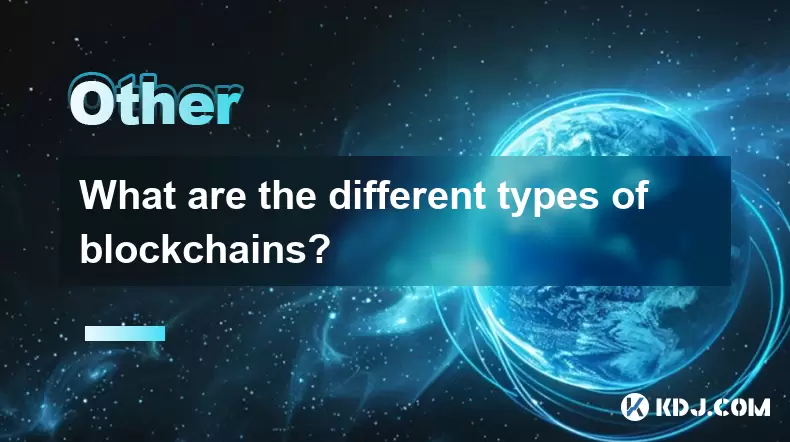-
 Bitcoin
Bitcoin $112400
-1.07% -
 Ethereum
Ethereum $3409
-3.27% -
 XRP
XRP $2.784
-6.60% -
 Tether USDt
Tether USDt $0.9997
-0.03% -
 BNB
BNB $739.3
-2.09% -
 Solana
Solana $158.0
-2.90% -
 USDC
USDC $0.9998
-0.02% -
 TRON
TRON $0.3213
-0.94% -
 Dogecoin
Dogecoin $0.1929
-5.01% -
 Cardano
Cardano $0.6974
-2.82% -
 Hyperliquid
Hyperliquid $36.69
-2.31% -
 Sui
Sui $3.327
-4.80% -
 Stellar
Stellar $0.3672
-5.18% -
 Chainlink
Chainlink $15.65
-3.07% -
 Bitcoin Cash
Bitcoin Cash $525.0
-1.68% -
 Hedera
Hedera $0.2291
-6.00% -
 Avalanche
Avalanche $20.91
-2.96% -
 Ethena USDe
Ethena USDe $1.000
0.00% -
 Toncoin
Toncoin $3.520
-1.12% -
 UNUS SED LEO
UNUS SED LEO $8.968
0.14% -
 Litecoin
Litecoin $105.7
0.26% -
 Shiba Inu
Shiba Inu $0.00001181
-1.79% -
 Polkadot
Polkadot $3.492
-2.08% -
 Uniswap
Uniswap $8.800
-3.10% -
 Dai
Dai $0.9999
-0.01% -
 Monero
Monero $289.9
-3.17% -
 Bitget Token
Bitget Token $4.243
-1.27% -
 Pepe
Pepe $0.00001006
-3.67% -
 Cronos
Cronos $0.1248
-5.68% -
 Aave
Aave $249.7
-2.50%
What are the core technologies of blockchain? What are their respective functions?
Blockchain's core technologies—DLT, cryptography, consensus mechanisms, smart contracts, dApps, and interoperability protocols—enable secure, transparent, and efficient digital transactions and data management.
Apr 27, 2025 at 02:00 pm

Blockchain technology, since its inception with Bitcoin in 2009, has revolutionized the way we think about digital transactions and data management. At its core, blockchain is a decentralized and distributed digital ledger used to record transactions across numerous computers, ensuring that the recorded data is immutable and transparent. To understand the full scope of blockchain technology, it is essential to delve into its core technologies and their respective functions. In this article, we will explore these technologies in detail, highlighting their importance and how they contribute to the overall functionality of blockchain systems.
Distributed Ledger Technology (DLT)
Distributed Ledger Technology (DLT) forms the backbone of blockchain. It is a database that is consensually shared and synchronized across multiple sites, institutions, or geographies, accessible by multiple people. Unlike traditional databases managed by a central authority, DLT allows data to be stored across a network of decentralized nodes, ensuring no single point of failure.
The primary function of DLT is to enable secure, transparent, and immutable record-keeping. By distributing the ledger across numerous nodes, it becomes incredibly difficult for any single entity to manipulate the data. This feature is crucial for applications like cryptocurrency transactions, where trust and security are paramount. DLT also facilitates real-time updates and synchronization, ensuring all participants have access to the most current data.
Cryptography
Cryptography is another fundamental technology in blockchain, providing the security and integrity that the system requires. It involves the use of cryptographic algorithms to secure transactions, control the creation of new units, and verify the transfer of assets.
In blockchain, cryptography serves several critical functions. Firstly, it ensures the privacy of transactions through the use of public and private keys. Each user has a pair of keys: a public key, which is openly shared and used to receive transactions, and a private key, which is kept secret and used to sign transactions. Secondly, cryptographic hash functions are used to create a unique digital fingerprint for each block, ensuring that once data is recorded, it cannot be altered without changing the hash of subsequent blocks. Lastly, digital signatures provide a way to verify the authenticity of transactions, ensuring that only the owner of the private key can authorize a transaction.
Consensus Mechanisms
Consensus mechanisms are protocols that ensure all participants in a blockchain network agree on the current state of the distributed ledger. They are essential for maintaining the integrity and security of the blockchain, as they prevent fraudulent transactions and ensure that all nodes have a synchronized copy of the ledger.
There are several types of consensus mechanisms, each with its own strengths and weaknesses. Proof of Work (PoW), used by Bitcoin, requires nodes (miners) to solve complex mathematical puzzles to validate transactions and add new blocks to the chain. This process is energy-intensive but provides a high level of security. Proof of Stake (PoS), on the other hand, selects validators based on the number of coins they hold and are willing to "stake" as collateral. PoS is more energy-efficient and faster than PoW but may be less secure. Other mechanisms include Delegated Proof of Stake (DPoS) and Practical Byzantine Fault Tolerance (PBFT), each designed to address specific needs and challenges within different blockchain applications.
Smart Contracts
Smart contracts are self-executing contracts with the terms of the agreement directly written into code. They run on the blockchain, automatically enforcing and executing the terms of a contract when predetermined conditions are met.
The function of smart contracts is to automate and streamline processes that traditionally require intermediaries, such as legal or financial institutions. By running on a decentralized network, smart contracts reduce the risk of fraud and increase efficiency. They are widely used in various applications, including decentralized finance (DeFi), supply chain management, and digital identity verification. Ethereum, the first platform to implement smart contracts, has paved the way for a wide range of decentralized applications (dApps) that leverage this technology.
Decentralized Applications (dApps)
Decentralized Applications (dApps) are applications that run on a blockchain or peer-to-peer network of computers rather than a single computer. They are built on top of blockchain technology and utilize its core features to offer a wide range of services.
The primary function of dApps is to provide decentralized services that are resistant to censorship and single points of failure. They can be used for a variety of purposes, including gaming, social networking, and financial services. dApps leverage the security and transparency of blockchain to create trustless systems where users can interact directly with each other without the need for intermediaries. Examples of popular dApps include decentralized exchanges (DEXs), lending platforms, and non-fungible token (NFT) marketplaces.
Interoperability Protocols
Interoperability protocols are technologies designed to enable different blockchain networks to communicate and share data with one another. As the blockchain ecosystem grows, the need for interoperability becomes increasingly important to facilitate seamless interactions between different platforms.
The function of interoperability protocols is to bridge the gap between isolated blockchains, allowing them to work together more effectively. This can be achieved through various methods, such as cross-chain atomic swaps, sidechains, and blockchain bridges. Interoperability protocols are crucial for the development of a more interconnected and efficient blockchain ecosystem, enabling users to transfer assets and data across different networks without the need for centralized intermediaries.
Frequently Asked Questions
Q: How does the use of cryptography in blockchain ensure the security of transactions?
A: Cryptography in blockchain ensures the security of transactions through several mechanisms. Public and private keys provide privacy and control over transactions, while cryptographic hash functions create immutable records. Digital signatures further enhance security by verifying the authenticity of transactions, ensuring that only authorized parties can initiate transfers.
Q: What are the main differences between Proof of Work (PoW) and Proof of Stake (PoS) consensus mechanisms?
A: The main differences between PoW and PoS lie in their validation processes and resource requirements. PoW requires miners to solve complex mathematical puzzles, which is energy-intensive but provides high security. PoS, on the other hand, selects validators based on the number of coins they hold and are willing to stake, making it more energy-efficient but potentially less secure.
Q: Can smart contracts be used for purposes other than financial transactions?
A: Yes, smart contracts can be used for a wide range of purposes beyond financial transactions. They are employed in supply chain management to automate processes and ensure transparency, in digital identity verification to securely manage personal data, and in decentralized applications for various functions such as governance and voting systems.
Q: Why is interoperability important in the blockchain ecosystem?
A: Interoperability is important in the blockchain ecosystem because it allows different blockchain networks to communicate and share data, facilitating seamless interactions and enhancing the overall efficiency of the system. It enables users to transfer assets and data across different networks without the need for centralized intermediaries, promoting a more interconnected and robust blockchain ecosystem.
Disclaimer:info@kdj.com
The information provided is not trading advice. kdj.com does not assume any responsibility for any investments made based on the information provided in this article. Cryptocurrencies are highly volatile and it is highly recommended that you invest with caution after thorough research!
If you believe that the content used on this website infringes your copyright, please contact us immediately (info@kdj.com) and we will delete it promptly.
- BlockDAG, SEI, Ethena: Top Crypto Performers Under the Microscope
- 2025-08-03 10:50:16
- Bitcoin Blasts Past $119K: How Institutional Adoption and Macro Shifts Fuel the Fire
- 2025-08-03 10:55:16
- Crypto, Grok, and August: Decoding the Latest Trends and Insights
- 2025-08-03 11:10:16
- Crypto, Phishing, and Your Wallet: A New Yorker's Guide to Staying Safe
- 2025-08-03 10:30:16
- Troller Cat Meme Coin Presale Soars: A New King in the Crypto Jungle?
- 2025-08-03 10:30:16
- Grayscale, Altcoin Trust, and Mid-Cap Mania: What's the Deal?
- 2025-08-03 08:50:16
Related knowledge

What is the difference between on-chain and off-chain transactions?
Aug 02,2025 at 04:22pm
Understanding On-Chain TransactionsOn-chain transactions refer to digital asset transfers that are recorded directly on a blockchain ledger. These tra...

What is the double-spending problem and how does blockchain prevent it?
Aug 02,2025 at 01:07pm
Understanding the Double-Spending ProblemThe double-spending problem is a fundamental challenge in digital currency systems where the same digital tok...

What is the difference between a blockchain and a database?
Aug 01,2025 at 09:36pm
Understanding the Core Structure of a BlockchainA blockchain is a decentralized digital ledger that records data in a series of immutable blocks linke...

How does blockchain handle scalability?
Aug 02,2025 at 02:58pm
Understanding Blockchain Scalability ChallengesBlockchain scalability refers to a network's ability to handle an increasing volume of transactions wit...

What are the different types of blockchains?
Aug 03,2025 at 03:01am
Public Blockchains: Open and Decentralized NetworksPublic blockchains are the most widely recognized type of blockchain, characterized by their open a...

What is a hash in a blockchain?
Aug 02,2025 at 05:28am
Understanding the Concept of Hash in BlockchainA hash in the context of blockchain technology refers to a unique digital fingerprint generated by a cr...

What is the difference between on-chain and off-chain transactions?
Aug 02,2025 at 04:22pm
Understanding On-Chain TransactionsOn-chain transactions refer to digital asset transfers that are recorded directly on a blockchain ledger. These tra...

What is the double-spending problem and how does blockchain prevent it?
Aug 02,2025 at 01:07pm
Understanding the Double-Spending ProblemThe double-spending problem is a fundamental challenge in digital currency systems where the same digital tok...

What is the difference between a blockchain and a database?
Aug 01,2025 at 09:36pm
Understanding the Core Structure of a BlockchainA blockchain is a decentralized digital ledger that records data in a series of immutable blocks linke...

How does blockchain handle scalability?
Aug 02,2025 at 02:58pm
Understanding Blockchain Scalability ChallengesBlockchain scalability refers to a network's ability to handle an increasing volume of transactions wit...

What are the different types of blockchains?
Aug 03,2025 at 03:01am
Public Blockchains: Open and Decentralized NetworksPublic blockchains are the most widely recognized type of blockchain, characterized by their open a...

What is a hash in a blockchain?
Aug 02,2025 at 05:28am
Understanding the Concept of Hash in BlockchainA hash in the context of blockchain technology refers to a unique digital fingerprint generated by a cr...
See all articles

























































































